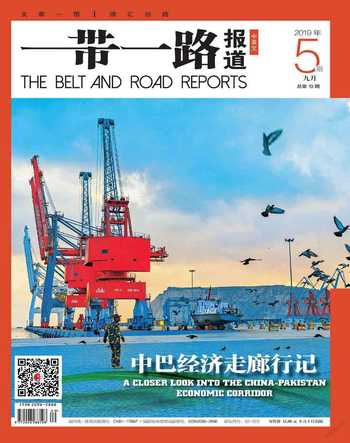点一盏灯,让世界亮起来
2019-09-10王义桅
王义桅
“像西天取经一样充满了曲折。”这是笔者2017年率外交部南亚宣讲团在尼泊尔、巴基斯坦、阿富汗三国宣讲“一带一路”的切身感受。
从巴基斯坦飞往邻国阿富汗,却要到迪拜转机,中转时间长达10个小时,几天才会有一趟直飞航班。南亚的很多国家即便是邻国也缺少互联互通,交通非常不方便。非洲也是一样的情况,不少邻国间没有航班,甚至没有公路和铁路连接。去一个非洲邻国,有时需要先飞去巴黎再转机回到非洲。
俗话说“要致富先修路,要快富修高速”。笔者还认为,“要闪富通网路”,在一个国家的发展中,民生工程至关重要。“一带一路”倡议提出后,很多国家愿意与中国合作,希望搭乘中国发展的“快车”。
“中国为什么发展这么快?”这是很多外国领导人的疑问。习近平主席曾这样回答:中国走了一条符合本国国情的发展道路。
巴基斯坦的能源短板非常明显,尤其是在用电方面。给中国来的朋友开电风扇,是很高的待遇。巴基斯坦电费很贵,且经常停电,国内第一大城市卡拉奇一年有1000多个人被热死。到目前为止,世界上仍然还有11亿人没有用上电。
从卫星上看夜晚的地球,只有日本、北美和欧洲发达国家和中国沿海地区灯火辉煌,而在其他地方看不见灯光。从侧面可见,这些地方的人民依然生活在“贫困的黑暗”之中。
如何让黑暗的地方灯亮起来?印度谚云:点一盏灯,让世界亮起来。“一带一路”倡议就是给广大的发展中国家点一盏灯,让普通老百姓看得到光芒,让这些国家看到希望。
在巴基斯坦的一个小学,一间小破屋,几百个人挤在一起,席地而坐,连桌椅都没有。孩子们的头顶上,蚊子苍蝇满天飞,没有电风扇热得要命。“为什么他们生活在连电都没有的时代里呢?”
2015年9月,习近平主席在联合国总部提出“智能电网+特高压电网+清洁能源”三位一体的全球能源互联网计划,体现了中国因地制宜、统筹协调、综合施策的中国方案和中国智慧。
“一带一路”沿线国家能源和需求分布不均衡。水能主要集中在中国西南、俄罗斯、东南亚等地区;风能主要集中在中国“三北”(东北、华北、西北)、蒙古国、中亚及俄罗斯北部沿海等地区;太阳能主要集中在西亚、中国青藏高原等地区。
因此,构建全球能源互联网,总体分为国内互联、洲内互联、洲际互联三个阶段,力争在21世纪中叶基本建成。届时,全球清洁能源比重可提高到80%以上;全球二氧化碳排放可控制在115亿吨左右,仅为1990年排放量的一半,可实现全球温控2℃以内的目标;逐步形成电能主导、清洁发展的能源格局。世界将成为一个能源充足、天蓝地绿、亮亮堂堂、和平和谐的“地球村”。

中國方案源于国内的成功实践一一西电东送、北电南供、水火互济、风光互补、跨国互联的电力发展格局,如果国内没有互联互通,如何实现全球互联互通?
“己欲立而立人,己欲达而达人。”中国在很多发展中国家眼中,已经“达”了。而现在我们要“达”兄弟国家。“一带一路”倡议与联合国推动落实2030年可持续发展议程不谋而合,中国正在推动以发展为导向的“全球化”,以民生、基础设施、实体经济为发力点。中国的改革开放使7亿人脱贫致富,现在中国的“一带一路”建设不以任何政治条件为前提,用资金搞项目,促进相关国家的就业,可以说是“功德无量”。
中巴经济走廊建设是“一带一路”倡议下的旗舰项目,中国正在帮助巴基斯坦补齐能源及基础设施的短板,同时还帮助当地建造港口、建设开发区。以中国移动公司为例,21个中国年轻人雇用了3200个巴基斯坦“白领”,公司管理效率很高,大家都很珍惜这份工作。在巴基斯坦,能体验到“Zong”最快的4G速率。
“中国!”很多巴基斯坦人都会说这两个汉字,中国人来了很多巴基斯坦人都会争相合影。在那里,人人都知道中巴经济走廊。“中巴两国友谊比喜马拉雅山还要高,比印度洋还要深,比蜜还要甜,比钢还要硬……”这是巴基斯坦人民常挂在嘴边的话。
It is a journey full of twists and turns, just like the“Journey to the West.” That was how I felt when I led the South Asia-bound delegation of the Ministry of Foreign Affairs to preach on the Belt and Road in Nepal, Pakistan, and Afghanistan in 2017.
You have to transfer flight via Dubai if you are to fly from Pakistan to neighboring Afghanistan, which entails as long as 10 hours. A direct flight is only available every few days. In South Asia, many neighboring countries are not yet connected and thus inaccessible. The case is also true with Africa, where no flights are available among many neighboring countries, and in the worst scenario, there is even no highway and railway. An African has to fly to Paris before transferring to another African country.
As the saying goes, “To get rich, build a road; to get rich quickly, build a high-speed railway.” I also think that if we want to get rich immediately, we should build a network. It tells us that livelihood projects are essential to national development. Since the Belt and Road Initiative was initiated, many countries have expressed their willingness to cooperate with China and hitchhike on China’s economic development.
“How has China managed to develop so fast?” That is a common question among many foreign leaders. The answer of President Xi Jinping is: China has pursued a development road that fits its national realities.
Pakistan is confronted with serious energy shortage, particularly electricity. The highest courteous reception a Chinese people can receive in Pakistan is enjoying the coolness of an electric fan. The country faces high electricity price and frequent blackout. Each year, as many as 1,000-plus people die of heat in Karachi, the largest city in Pakistan. As of today, there are still 1.1 billion people on the earth who have no access to electricity.
A bird’s-eye view of the earth from satellite shows that only in Japan, North America, developed European countries and coastal regions of China are well-illuminated at night, while the rest parts of the world are black. It tells us that people in these regions are still living in “the darkness of poverty”.
Then how to illuminate the dark regions? An Indian adage said: lit a lamp to lighten the world. The Belt and Road Initiative is designed to lit lamps in developing countries and bring light and hope to ordinary people.
In a primary school in Pakistan, several hundred students sit together on the ground of a shabby room with no desks and chairs. With mosquitoes and flies swirling overhead, the children are scorched in heat with the absence of electric fan. “Why they live in such a world devoid of electricity?”
In September 2015, President Xi Jinping proposed the Global Energy Interconnection(GEI) plan in the United Nations Headquarters, a Chinese plan featuring Chinese wisdom where local conditions are considered, overall plans are made in a coordinated way, and holistic approaches are taken.
The energy of the countries along the Belt and Road is unevenly distributed: hydropower mainly concentrates in Southwest China, Russia, and Southeast Asia; wind power can mainly be found in Northeast China, Northern China, and Northwest China, Mongolia, Central Asia, northern coastal regions of Russia, and other areas; solar power is mainly in West Asia, China’s Qinghai-Tibet Plateau, and other regions.
Therefore, the developing of GEI consists of three stages: domestic interconnection, intra-continental interconnection, and inter-continental interconnection, aiming to complete the task by the mid of the 21st century. By then, the global share of clean energy will exceed 80%; the global emission of carbon dioxide will be capped at around 11.5 billion tons, only half of that of 1990, and global temperature rise will be less than two degrees centigrade; as such, an energy layout featuring the dominance of electricity and clean development will be shaped. Then the world will become a harmonious, well-illuminated “earth village” with abundant energy, blue sky and green land, and peace.
The China plan originated in the best practice at home: a power development pattern of power transmission from west to east and from north to south, mutual supply of hydropower and thermal power, mutual complementation of wind power and solar power, and trans-national interconnection. With no interconnection at home, global interconnection will be impossible.
“Help others to become independent if you are to be independent; help others to rise high if you aim high.” In the eyes of many developing countries, China is already a developed country that rises high. Now it is our task to help these countries to rise high too. The Initiative echoes with the UN 2030 Agenda for Sustainable Development. China is pushing for a developmentoriented globalization, with livelihood, infrastructure, and real economy as drivers. China’s reform and opening up has lifted 700 million people out of poverty. The Initiative comes with no political conditions since it uses capital to launch projects and promote employment in relevant countries. That is why we can say that it is a project with boundless beneficence.
China-Pakistan Economic Corridor is a flagship project under the Initiative. China is helping Pakistan in shoring up its weak links in energy and infrastructure, and in building ports and constructing development zones. A case in point is China Mobile, where 21 Chinese young people employ 3,200 Pakistani white-collar workers. In the highly efficient company, everyone cherishes the job. In Pakistan, you can experience the fastest 4G.
“Zhong Guo(China)!” Many Pakistani can say the two characters and scramble to take photos with Chinese visitors. It is a country where everyone knows China–Pakistan Economic Corridor. “China-Pakistan friendship is higher than the Himalayas, deeper than Indian Ocean, sweeter than honey, and harder than steel...”, that is something on the lips of Pakistani people.
